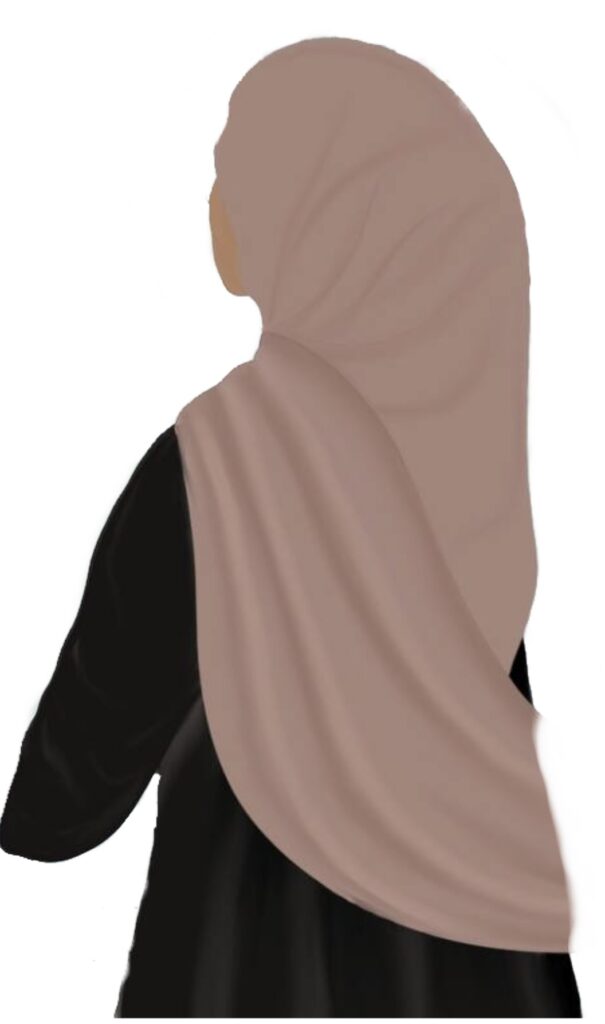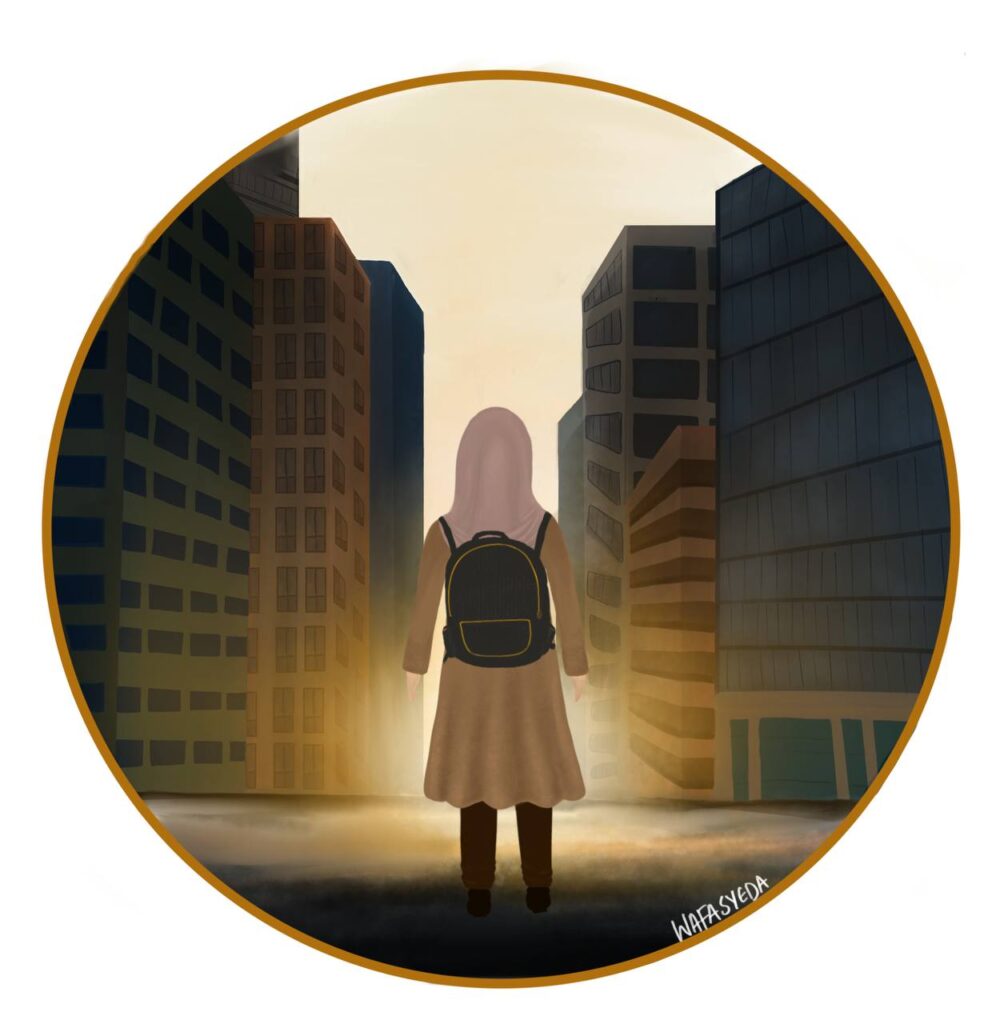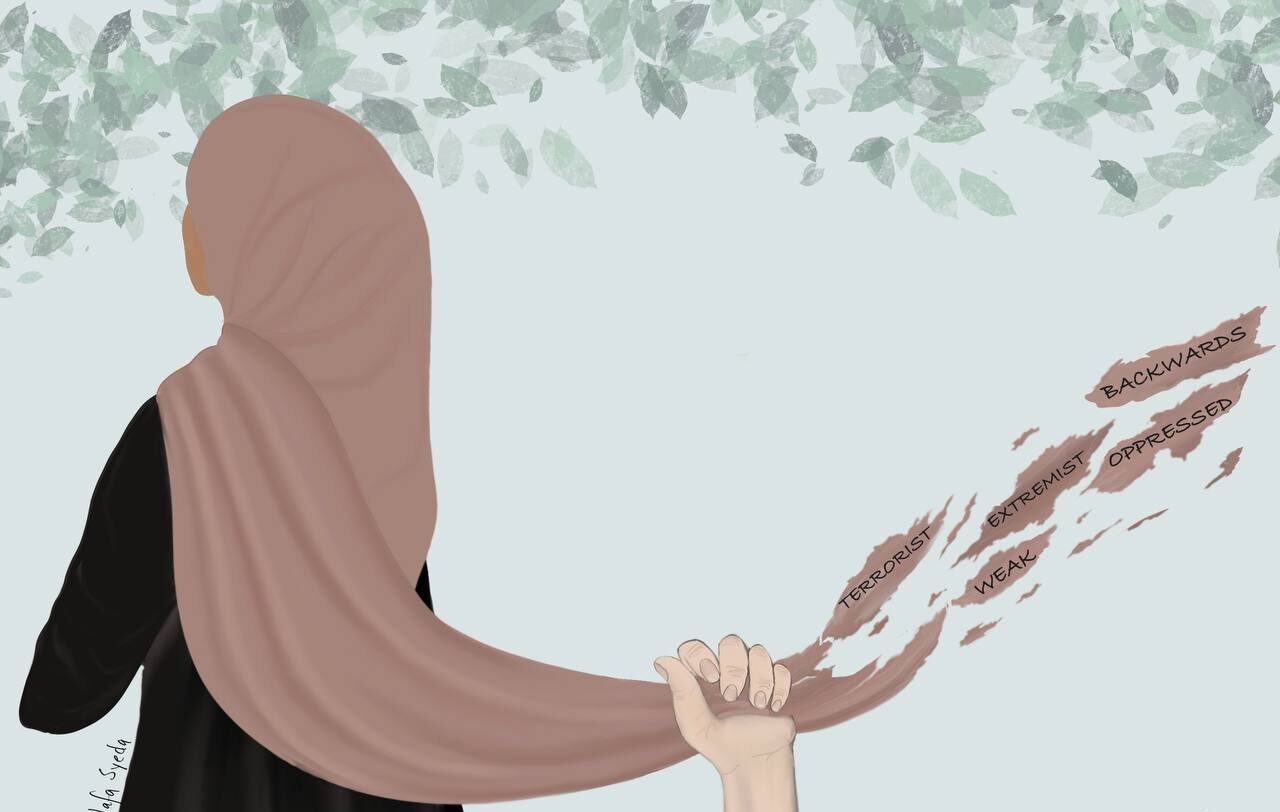The hate can be unbearable, but I refuse to take it off.
BY WAFA SYEDA
ART BY WAFA SYEDA
———————————————————–
“Are we there yet?” asked eight-year-old me for the fifth time in 35 minutes. We were on our way to a religious procession in downtown Toronto. Every year, during the Islamic month of Muharram, Muslims gather together to commemorate the anniversary of Imam Hussain’s death, who was the grandson of Prophet Muhammad. “Are we there yet?” I asked one more time, but this time, I didn’t get a response. Instead, my dad turned down the radio playing CityNews 680 and slowed the car. “Put your window up, Wafa,” I vividly recall my older sister saying.
“Why?” I asked.
Her tone immediately changed. “Wafa! Put your window up NOW!”
My dad used the controls on his door and rolled the window until it was shut. As we drove by the area where the volunteers for the procession were setting up, I looked out my window to see a handful of people on the side of the road in jackets, hats, scarves, and gloves, spitting violently at our car.
With quick reflexes, I took off my seat belt and squeezed into my sister who sat on my left. My eyes fixated on the people with furrowed eyebrows and explosive hand movements. I listened to the muffled noises of them screaming at us, and I knew something was wrong.
“Daddy, what was that for?” I asked in a startled voice.
“Wafa, we talked about this.” He spoke to me in Urdu as he pulled onto the side of the road to drop off the two large speakers used in the procession.
“Daddy, daddy, don’t stop here! Keep going, keep going,” my sister and I kept screaming.
“It is okay. I am here. Nothing to worry about, okay?” he said in his calm voice. “Remember when I told you that there are some people in the world who do not understand us? They don’t know about us and what we stand for, and so they react in their ignorance.”
We were far away from the group now, but I could still see people screaming at the car behind us. Our rusted old Ford Windstar minivan seemed safe at the moment. My dad stepped out and opened the trunk to take the gigantic speakers out along with its heavy-duty green stand. A few other volunteers joined to help. My mom was waking my five-year-old brother out of his booster seat as my sister and I stood right beside her, with one hand firmly latching the bottom of her kameez, a type of dress commonly worn in Pakistan.
“Meanies!” I huffed as my other hand was firmly glued to my sister’s arm.
This was my first Islamophobic encounter.
My First Hijab
Growing up, my parents never forced the hijab on me or my sister. My sister had a deep love for the hijab and, like any younger sister, if she had one, I wanted one too. My first hijab was two-pieced, light brown with a marbled design, and sequins spread apart. My mom sewed it herself after we bought the fabric earlier that day. One for me and one for my sister.
My sister started wearing the hijab at the age of seven, two years earlier than the age many girls begin wearing it. Red, blue, pink, purple, polka dots, animal stripes, patterns—my sister had a gold mine of them. I started around that age too, but I didn’t wear it as regularly as her until I was nine. My mom has a passion for sewing, so she hand-sewed all the hijabs and cultural clothing we owned. I knew I looked unlike the other kids, but that never bothered me until much later. Wearing the hijab made me feel different—it made me feel cool.
“That colour is so cute!” “Wow, you look so nice!” “Your hijab matches my shirt!” I would drown in happiness from these comments. Everyday I would wake up excited to wear the hijab to school.

“I was one of the handful of students with brown skin in the entire school. The fire in me to become a teacher soon started to burn out.”
I always wanted to be a teacher. Before going to school, I fantasized about the red pens, story time, and bonding with other students. Unlike many children who cry on their first day of school, I ran into class without waving goodbye to my parents. Little did I know, school would be far from how I imagined it to be. From Grades 1 to 3, I was consistently neglected—often placed at the naughty kid’s table at the back of the class. Many kids say this, but I really wasn’t a bad kid. I was calm, but extroverted—much like the other kids in my class. As the days went by, I was singled out more than other students. The smiling, laughing, art-loving, jolly little Wafa soon began losing her passion and joy in learning. I quickly became more introverted.
While my teacher would pack homework in every other student’s bag, I had to do it on my own. On the wall at school, there was a piece of paper dedicated to each member of the class. Upon doing something good, the teacher would put a sticker on their page, and the student with the most stickers would receive an award. I hardly ever got a sticker. In fact, I don’t recall receiving the paper until several weeks after the school year began. I didn’t wear a hijab then, but my mom did. I was one of the handful of students with brown skin in the entire school. The fire in me to become a teacher soon started to burn out. Envisioning a future in the classroom was challenging—I was made to feel like I didn’t belong there.
Apparently, I’m a Terrorist
“I’m scared. I’m terrified to come to school, because what if someone pulls off my hijab?” says Razia Sayyeda, a third-year English student at Toronto Metropolitan University. Sayyeda had been studying for her midterm exams, until she caught herself looking at an old article about a hijabi girl being pushed onto the subway tracks. As a frequent subway user, it scared her. “I did not sleep that night,” she says. “At one point I was like, ‘I’ll skip my exam. It’s only 30 per cent of my mark.’”

Days after speaking to Sayyeda, around 11:30 a.m. on a Wednesday, I was heading back home after completing my history midterm exam. I was taking the southbound subway line to Union Station to catch the 12:34 Kitchener line train. Making my way up the escalators, I noticed there was hardly anyone there. Unusual.
The payment machines were still a few steps away when, suddenly, a man in a hooded black jacket appeared. He wore a black baseball cap, which made his facial features hard to see. The loose ends of my hijab blew with each huff and puff as he walked behind me, heavy footsteps echoing on the empty platform.
“Go back to where you came from!”
I remembered what Sayyeda told me. I tucked the loose corners of my hijab into my cardigan.
“Go back! Go Back! Go Back!”
I tapped my card to go through the gates. A handful of people looked at me as if they wanted to ask if I was okay. But no one did. I got in the subway car and stood as if unfazed, but questions ran through my mind: Am I asking for trouble when I wear my hijab? Is it fair to complain and ask for help when I choose to wear it? These thoughts filled me with guilt, and I never told the authorities what happened.
The Fist and French Vanilla
It was my fall 2019 semester. I remember the ice-cold weather walking to my politics class. I took a pit stop. I grabbed a French vanilla from the Tim Hortons on Victoria Street to stop my mitten-less hands from shaking. I was running late, so I pushed through the doors, which felt heavier than usual. I was flipping down the tab of the white lid so I could take a quick sip when I saw a musty old hand coming straight at my face. His fingers were tucked in, making a tight fist. In between the creases of his skin on his knuckles was a collection of dirt. Everything flashed before my eyes. I thought of my parents, my siblings, my friends. I shifted my eyes away from the fist and onto the security guard who always stood on the corner of Yonge and Victoria Street, just a few feet away from me. He watched. I looked back at the fist, closed my eyes and called out to God. I pathetically froze, waiting for what was to come.
But the man ran away, grunting muffled racial slurs. My hands started shaking again. I dumped the cup and began speed-walking away, constantly looking back to make sure he wasn’t following me. I kept telling myself: Nothing happened, you are okay.
And the Hate Continues
When the COVID-19 pandemic kept everyone confined in their homes, many people started taking daily walks around their neighborhoods. I would go out in the afternoon and take a walk with my family to the nearby park. This stopped when we heard the news: a hate-motivated murderer had taken the lives of four members of the Afzaal family in London, Ontario, leaving the youngest injured and orphaned. It sparked fear in many Muslim families across Ontario, including mine. A simple task like taking an outdoor stroll instantly became more complicated. My friends and I met virtually. “That could have been one of us. In fact, that could have easily been my family. Or your family,” one of them said. “Even walking around the neighbourhood with our family isn’t safe for us anymore? When will being a Muslim not be a threat to our safety?”
“Nouser’s white skin was a privilege she didn’t take lightly, because she was often able to hide her Muslim identity—to a certain extent.”
The tragic death of the Afzaal family was one of many incidents that sparked discussions about the rise in hate crimes toward Muslims in Canada. In 2017, six worshippers were killed in a mosque in Quebec. In 2018, the Wali Ul Asr Learning Institute in Scarborough, a branch of the Islamic school I graduated from, was vandalized with an obscenity against Muslims written on the wall. In September 2020, a volunteer caretaker was sitting outside a mosque in Toronto near Kipling Avenue when he was stabbed to death. Three months later, two Somali women were attacked outside a shopping centre. A week later, a 23-year-old Black woman wearing the hijab was verbally abused and hit in the head with a shopping bag at an Edmonton transit station. That same year, a teenage girl in Calgary, who was wearing the hijab, was assaulted while walking along the river pathway. Police said that the woman pushed her to the ground, tore off her hijab, punched and kicked her in the face and stomach while screaming racial and Islamaphobic slurs. Within one week of each other in April of 2023, there were two separate reported hate crimes at mosques in Markham, Ontario. At one, a man allegedly shouted slurs before driving his vehicle straight at a worshiper. In the second incident, a man blocked the entrance to a mosque with his car, yelled derogatory slurs, and assaulted several people before driving away.
From 2010 to 2019, about half of the crimes against Muslims were violent, with the most frequent crimes being common assault, which made up 25 per cent, and uttering threats, which made up 42 per cent. Generally, most violent hate crimes related to religion occur within religious institutions, according to Statistics Canada. But for Muslims, most occur in open areas such as malls, parks, and public transportation. Wearing the hijab makes Muslim women more susceptible to hate crimes. Of all violent crimes against Muslims, women and girls make up about 47 per cent.
Who Else?
In 2015, Mariam Nouser filed a police complaint for physical abuse. Nouser is a mom of two, a social media influencer, and a freelance journalist. Back then, though, she was an 18-year-old who had just started wearing the hijab full-time. It was a decision she didn’t take lightly. It took several years for her to work up the courage to take it on. She made an oath to herself when she was 15 that if this strength did not come by the time she graduated high school, she would face her fears and put it on regardless. She saw her female relatives who lived in Egypt take on the hijab, which inspired her to do the same.
Nouser was six when 9/11 occurred. Her dad, being a visibly brown man named Hussein, was an easy target. She says that in the early 2000s, he was beaten and arrested without cause by B.C. police. She didn’t know about this until she turned 13, but when she found out, she was immediately afraid to wear the hijab. She says her white skin was a privilege she didn’t take lightly, because she was often able to hide her Muslim identity—to a certain extent.
In July 2013, Nouser got accepted into one of her top choice schools, Toronto Metropolitan University (TMU). That was also the year she decided to begin her lifelong journey with the hijab. Her grandmother is her biggest supporter when it comes to wearing it, even though she isn’t Muslim. A few years prior, when a couple of her grandmother’s friends came by her house, they told Nouser, who had put on a prayer scarf, “Hon, you don’t need to wear that, you are in Canada.” Her grandmother went silent for a couple of seconds and then said, “She can do whatever the hell she wants!”
“I mean, you spit on me and then call me oppressed—how does that work?”
A year after Nouser began wearing the hijab, she experienced an Islamophobic attack. It was July 2014, and TMU’s Muslim Student Association (MSA) held a meeting at the library to discuss the events and logistics for the next term. Coming from Kipling Station, Nouser put her headphones on and sat near the doors. Due to a long commute, she decided she would stop and stretch at the St. George subway station, when she noticed a woman staring at her. As she was about to get off, she felt a bit of liquid seep through her lightweight viscose hijab and onto her neck. It was spit. She felt a tug at her hijab pulling her head backwards. She took her headphones off and heard the lady sitting behind her say, “Go back to where you came from, you terrorist!” Confused, scared, and utterly shocked, the only words to leave her mouth were, “But I come from Etobicoke.”
“I use comedy as a way to cope,” she says.
The incident made Nouser realize she wasn’t ready to wear the hijab, so she decided to take it off. Then, in 2015, she had a dream where her paternal grandfather told her to be brave. She took it as a sign to put the hijab back on again. This time, however, she wore it with a renewed sense of confidence.
That September, she and two of her friends from TMU were heading back to Kipling Station when a man with slurred speech and clumsy footing cornered her, screaming, “You are a terrorist! If I had a gun, I would shoot you right in the head.” On the outside, she sat confidently and stared him dead in the eyes. On the inside, she feared for her safety. Nouser believes that looking weak makes you an easy target. Suddenly, a fellow passenger—with the largest cross Nouser had ever seen dangling from his neck—got up from his seat and yelled, “No, you are the f—ing terrorist!” Appreciating the gesture, Nouser called her mom at High Park the second she got cell service and headed straight to the police station at 22 Division, right outside the stop. She filed a complaint for physical abuse, but upon investigation, they found out the cameras were down. Due to the lack of proof, the case was shut.
No One Would Help Me
I remember feeling helpless when the security guard stood still as the man was about to punch me. I have seen people who have power either misuse or not use it when it is needed most—whether it be my teacher who neglected the quality of my education or the security guard who watched passively as I nearly faced an assault.
When I was 13, I was a junior volunteer at the same religious procession where people had screamed at my family’s car five years earlier. I wore the oversized orange and yellow vest meant for adults, but I couldn’t care less. I knew I looked cool. The procession began at Queen’s Park in downtown Toronto. My job was to assist parents pushing strollers over the curb. There were always a handful of people who stood near the procession’s set-up only to disturb and cause trouble. They swore at people who passed by and would throw the word “terrorists” around. I prepared myself to see them again. The supervisors had told the young volunteers that we were not allowed to interact with the group and, if there were any complications, we had to let them know right away.

“When I wear the hijab now, I feel proud of my ancestors who fought hard to ensure my right to wear it.”
I was standing about a metre and a half away from the opposition group when I saw a mother struggling to get the front of her child’s stroller over the curb. I quickly rushed to her and bent down, lifting the front of the stroller to help her get across. As I got up, spit hit my face. There was a lady who looked like she was in her sixties with fading short red hair, a black and white striped shirt, and navy blue ankle pants. Standing between us was a police officer who was facing me. She exclaimed, “You are oppressed and you don’t know it, you terrorist!”
I have tried, many times, to understand what she was saying. Even today, it doesn’t make sense to me. I mean, you spit on me and then call me oppressed—how does that work? I looked at the six-foot-tall policeman, who must have seen what happened. He never said a word. He never moved a muscle. He just faced me.
I got it. He’s protecting this defenseless older white lady from 13-year-old brown, hijab-clad me.
I’ll Accept the Consequences
I knew my hijab was at the root of all the hate I faced. I often thought about how there wasn’t anyone who would help me in the face of danger. I thought that maybe I shouldn’t even blame them. After all, wearing the hijab was my personal choice and I was well aware of the consequences. I was fortunate enough that the Islamic school I graduated from began offering self-defense classes for students and alumni, and I was quick to join after what I had experienced.
If hate is a reaction to the hijab, does that mean I should take the hijab out of the equation? I found myself pondering this question—but not for long. Wearing the hijab may bring challenges into my life, but it also taught me how to understand the challenges of others. Most of all, it has given me something to fight for. When I wear the hijab now, I feel proud of my ancestors who fought hard to ensure my right to wear it. It serves as a constant reminder of the values and beliefs taught within my beautiful religion that not everyone can or will understand, hence the hate people like me tend to receive. I’ll accept the consequences, but I will never take off this so-called “repressive cloth.” My hijab is my confidence, not my weakness. It is my purpose, not my burden. It is my guide, not my obstacle.
I wish I could say I am not scared, but I am. I am scared every time I step out of my home. Each time I unlock the door of my house after a long day of school, my mom’s face is filled with relief. I asked her one day, “Mama, is everything okay?” She said, “You have no idea what goes through my heart every time you leave the house.”


